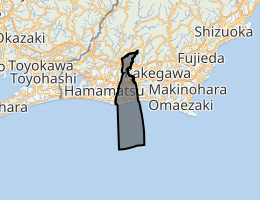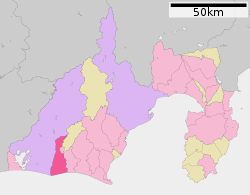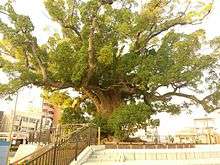Iwata, Shizuoka
Iwata (磐田市, Iwata-shi) is a city located in Shizuoka Prefecture, Japan. As of 1 May 2019, the city had an estimated population of 169,897 in 68,215 households [1] and a population density was 1,000 persons per km2. The total area of the city was 163.45 square kilometres (63.11 sq mi). Iwata widely known as the headquarters of the Yamaha Motor Corporation. Iwata is also home to Júbilo Iwata, a J. League soccer team, as well as Yamaha Jubilo, a rugby team.
Iwata 磐田市 | |
|---|---|
 Iwata City Hall | |
 Flag Seal | |

| |
 Location of Iwata in Shizuoka Prefecture | |
 Iwata | |
| Coordinates: 34°43′4.4″N 137°51′5.5″E | |
| Country | Japan |
| Region | Chūbu (Tōkai) |
| Prefecture | Shizuoka |
| Government | |
| • Mayor | Osamu Watanabe |
| Area | |
| • Total | 163.45 km2 (63.11 sq mi) |
| Population (March 2018) | |
| • Total | 169,897 |
| • Density | 1,000/km2 (2,700/sq mi) |
| Time zone | UTC+9 (Japan Standard Time) |
| Tree | Camphor |
| Flower | Azalea |
| Bird | Blue Rock-thrush |
| Phone number | 0538-37-4827 |
| Address | 3-1, Kōnodai, Iwata-shi, Shizuoka-ken 438-8650 |
| Website | www |

Geography
Iwata is located in southwestern Shizuoka Prefecture, bordered by the Tenryū River to the west and with a small coastline on the Pacific Ocean to the south.
Demographics
Per Japanese census data,[2] the population of Iwata has been increasing over the past 60 years.
| Year | Pop. | ±% |
|---|---|---|
| 1960 | 105,489 | — |
| 1970 | 111,452 | +5.7% |
| 1980 | 145,751 | +30.8% |
| 1990 | 157,219 | +7.9% |
| 2000 | 166,002 | +5.6% |
| 2010 | 168,616 | +1.6% |
Climate
The city has a climate characterized by characterized by hot and humid summers, and relatively mild winters (Köppen climate classification Cfa). The average annual temperature in Iwata is 16.3 °C. The average annual rainfall is 2077 mm with September as the wettest month. The temperatures are highest on average in August, at around 27.3 °C, and lowest in January, at around 6.1 °C.[3]
History
Iwata is an ancient settlement, and human habitation dates from the Japanese Paleolithic period, with obsidian tools and shell middens having been found. Numerous kofun burial mounds are also found in the area of the city, which came under the control of the Yamato dynasty around the time of the semi-legendary Emperor Seimu. The Nara period provincial capital and provincial temple of Tōtōmi Province were located in Iwata. During the Edo period, it developed as a post station on the Tokaidō highway connecting Edo with Kyoto and contained Mitsuke-juku, one of the 53 stations on the road.
With the establishment of the modern municipalities system of the early Meiji period on October 1, 1889, Mitsuke Town within Iwata District, Shizuoka was established. Later that year, Nakaizumi Town and Ninomiya Village merged to form Nakaizumi Town. These two towns merged on November 1, 1940 with Saikai Village and Tenryū Village to form the new town of Iwata. Iwata was raised to city status on April 1, 1948.
On April 1, 2005, the neighboring towns of Fukude, Ryūyō and Toyoda, and the village of Toyooka (all from Iwata District) were merged into Iwata.
Government
Iwata has a mayor-council form of government with a directly elected mayor and a unicameral city legislature of 26 members. The city contributes three members to the Shizuoka Prefectural Assembly.
Economy
The economy of Iwata is primarily agricultural and is known for green tea and melons grown in greenhouses, which are called "Iwata melon". The Yamaha Corporation was founded in Iwata and maintains a strong presence in the city. Yamaha Motor's headquarters is in Iwata. Suzuki Motor Corporation has a vehicle assembly plant in Iwata.
Education
Shizuoka Sangyo University, a private university, is located in Iwata.
Iwata has 23 public elementary schools and 11 public middle schools operated by the city government. The city has four public high schools operated by the Shizuoka Prefectural Board of Education. The prefecture also operates two special education schools for the disabled.
Iwata also has two international schools, the CEP Brasil – Centro Educacional e Profissionalizante – Brazilian school[4] and the Escola Objetivo de Iwata Tia Rosa, a Brazilian primary school[4] Iwata formerly hosted another Brazilian school, a primary school called Escola Nipo-Brasileira de Iwata.[5]
Transportation
Railway
.svg.png)
- Tenryū Hamanako Railroad Tenryū Hamanako Line
Highway
Sister City relations


Local attractions
National Historic Sites
- Tōtōmi Kokubun-ji
- Former Mitsuke School
- Mikuriyama Kofun group
- Shinpōinyama Kofun group
- Chōshizuka Kofun
Other

Near the north exit of JR Iwata Station is the Great Camphor tree of Zendo-ji. Believed to be 700 years old, it was once within the grounds of a Buddhist temple called Zendo-ji. Its height is 18.3 meters and its diameter at chest height is 2.87 meters. The root structure bulges out of the ground creating a second level, and the circumference at the portion touching the surface is 32.9 meters.
Notable people from Iwata
- Masami Nagasawa – actress
- Saori Atsumi – singer-songwriter
- Ryosuke Sasagaki – professional soccer player
- Jun Mizutani – professional table-tennis player
- Noriko Mizoguchi – judoka
- Mima Ito – professional table-tennis player
References
- Iwata City official statistics (in Japanese)
- Iwata population statistics
- Iwata climate data
- "Escolas Brasileiras Homologadas no Japão" (Archive). Embassy of Brazil in Tokyo. Retrieved on October 13, 2015.
- "Escolas Brasileiras Homologadas no Japão" (). Embassy of Brazil in Tokyo. February 7, 2008. Retrieved on October 13, 2015.
- "International Exchange". List of Affiliation Partners within Prefectures. Council of Local Authorities for International Relations (CLAIR). Archived from the original on 13 January 2016. Retrieved 21 November 2015.
External links


- Official website (in Japanese)